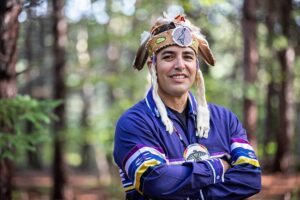A letter from Anishinabek Nation Grand Council Chief to all hunters and harvesters, and their families:
To all the Hunters and Harvesters, and their Families:

Aanii,
The 2021 hunting and harvesting season greets us with excitement. The Anishinabek Nation’s territory is one of the largest Indigenous landscapes in Canada and its unique geography provides great and wonderful opportunities for harvesting activities. Community harvesters in our Southwest Region can be found enjoying bird hunting in the early mornings and in November will be pursuing deer in their rut. In our Southeast Region, wild rice and corn harvests are in full swing. In addition, small and big harvesting activities are also taking place. In the Lake Huron and Northern Superior Regions, harvesters are combining upland game hunting with big game harvesting practices.
Whether your interest is in upland bird harvesting or large game such as moose or deer, it is important to recognize the non-Indigenous hunting seasons when exercising rights. Our territory will be filled with many people hunting and harvesting and safety must remain a priority for all. In fact, safety should be our number one priority.
I take a lot of pride in practicing and exercising the rights our ancestors left intact for us when harvesting. With these rights, also comes responsibility. Here are my top five (5) safety tips in preparation for harvesting this season:
1. Firearm safety
Practice firearm safety. Always keep the muzzle pointed in a safe direction. Keep it away from anyone, including yourself (even if it is not loaded). Always clear the firearm when not in use. Whenever you’re handling a firearm, treat it like it’s loaded.
2. Plan ahead
Be familiar with the area you want to hunt in. Map out the hunts and know where each person you are hunting with will be. Also, be aware of other activities that may be taking place in the hunting area. Non-hunting people like to take hikes in the bush and may have children or dogs with them. Having a plan with your entire hunting party is key to ensuring safety for all.
3. Dress right and have the right gear
The weather can change suddenly. Wear appropriate clothes that will keep you warm. Wear water repellent layer(s) to keep dry. Not a bad idea to wear hunter orange, too.
Also, bring a well-stocked backpack filled with food and water, water/windproof matches, compass, GPS, map, first-aid kit, knife, and last but not least, toilet paper.
4. Communication
Getting lost happens more often than most people know. Always let your hunting party, a close friend, and family member(s) know where you’ll be hunting. Cell phones and two-way radio (or CB radio) are great communication devices when you are in the bush. Cell phones may lose cell service; however, having a good functioning two-way radio is more reliable. Invest in a portable charger and spare batteries if possible.
5. Alcohol and drugs
Alcohol or drugs will impair your judgement. Never consume alcohol or drugs while handling a firearm. Do not go in the bush if you are under the influence. This only increases the risk of getting lost or causing harm to yourself or others.
With these tips and upholding our responsibilities as Anishinabek to all our relations, you’ll make your hunting trip a safer one for everyone in the forest and uphold our strong connections to Mother Earth and honour the gifts she has provided us. Let’s get out and do as our ancestors did. Remember to bring your tobacco and keep in mind the Seven Grandfather Teachings.
Wishing you all a safe hunt this harvest season,
Reg Niganobe
Grand Council Chief
Anishinabek Nation


